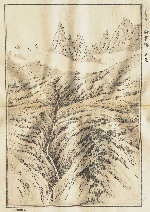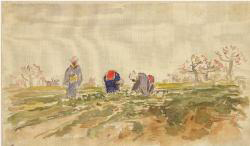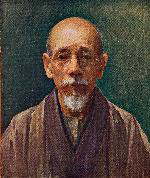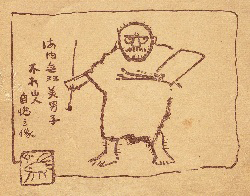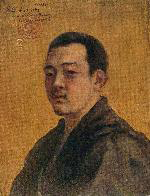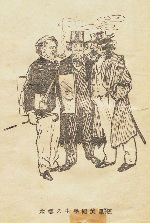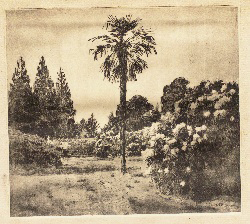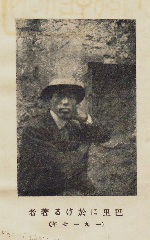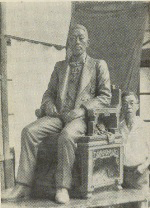![]()
Chapter 2: Art
Section 1: Artists who learned from France
Full-fledged creation of Western-style artworks began in Japan during the Meiji Enlightenment of the Meiji Era. At the Kobu Bijutsu Gakko (lit. Art School of the Ministry of Engineering), the first government operated art school in Japan, systematic education on Western painting and sculpting was carried out, and at first there were ultranationalism efforts to boycott, but gradually, painters and sculptors returning from overseas established Western-style painting and sculpting as a formative art. The majority of these artists who went overseas went to France, which was the center of the art world at the time. They learned advanced techniques and the spirit of the liberty under Art Nouveau glass artist Émile Gallé (1846-1904), foremost authority on modern sculpture François Auguste René Rodin (1840-1917), pleinairism painter Raphaël Collin (1850-1916), historical painter Jean Paul Laurens (1838-1921), et al. By placing themselves in a different climate than Japan, they were able to create a unique world that differed from the art which existed at the time.
Painters
TAKASHIMA Tokuzō, Ōshū sansui kishō, Kinkōdō, 1893 [16-179] 
Japanese-style painter TAKASHIMA Hokkai (Tokuzo, 1850-1931) also worked as an engineer for the Ministry of Engineering Mining Bureau, Ministry of Home Affairs Geography Bureau, and Ministry of Agriculture and Commerce Forestry Bureau. Except for being initiated into Nanga ( a style of Chinese painting) by his father, he also studied art on his own, however he had a great love for mountains, and he analyzed the objects of his paintings with his objective point of view based on the geology he learned from the French engineer François Coignet (1837?-1902) at the Mining Bureau and the forestry knowledge he learned while studying abroad at France's National School of Forestry in Nancy, and built his own unique world. He developed friendships with artists in Nancy, and its known that he lent a dictionary of plants, “Nihon Shokubutsu Meii” (lit. Nomenclature of Japanese plants) [75-65(洋)], to Émile Gallé. He was also praised for his contributions to cultural exchanges, such as donating 10 of his own ink-wash paintings to the Limoges Fine Arts Museum, and in 1888 he became the first Japanese to be awarded France's Order of Academic Palms. This work is a collection of colored wood block prints made up of 40 scenes of France, Italy and Scotland selected from among scenery sketches done while he made surveys of forests in various regions of Europe.
[ASAI Chu], ASAI Chū gachō, ASAI Chu [寄別3-1-2-1] 
ISHII Hakutei (Ed.), ASAI Chū, Unsōdō, 1929 [553-116] 
Western-style painter ASAI Chu received professional painting instruction from Italian teacher Antonio Fontanesi (1818-1882) at the Kobu Bijutsu Gakko (lit. Art School of the Ministry of Engineering) Department of Painting. From 1900 he studied abroad in France for 2 years, 6 months of which he spent in Grez-sur-Loing in southeast Paris, where Japanese painters including KURODA Seiki and WADA Eisaku (1874-1959), as well as a large number of artists from Britain, the United States and Northern Europe also stayed, and painted the landscapes that would become his representative works. After returning to Japan, he provided instruction to the next generation as a professor at the Kyoto College of Technology (present day Kyoto Institute of Technology) and as the first director of the Kansai Bijutsuin (lit. Kansai Art Institute), and a large number of famous artists, including ISHII Hakutei (1882-1958) and UMEHARA Ryuzaburo (1888-1986), were produced under his tutelage. He also worked on traditional Japanese painting, patterns for ceramics, dyeing and weaving; and magazine covers and illustrations. The Asai Chū gachō (lit. Book of paintings by ASAI Chu) is an accordion book which consists of 11 watercolor paintings on cloth and Japanese paper affixed one to each side on pasteboard sheets. Asai Chū is a biography by his disciple and includes a large number of pictorials of his works.
MATSUOKA Hisashi sensei denki hensankai (Ed.), MATSUOKA Hisashi sensei, MATSUOKA Hisashi sensei denki hensankai, 1941 [723.1-Ma86ウ] 
MATSUOKA Hisashi (1862-1944) was a Western-style painter who studied under Fontanesi at the Kobu Bijutsu Gakko (lit. Art School of the Ministry of Engineering), travelled to Europe in 1880 and graduated from the Royal Institute of Fine Art in Rome. He stayed in France for approximately 1 year from October 1887, and produced reproductions of the historical war paintings from the Palace of Versailles at the request of the Ministry of Imperial Household. This book was published by graduates from the Tokyo Higher Technical School, where MATSUOKA worked as an instructor. The first half covers the establishment of Juichijikai which opposed the exclusion of Western-style painting, the development of the National Industrial Exhibition, and the history of the division of the Meiji Bijutsukai (lit. Meiji Fine Arts Society) into the Hakubakai (lit. White Horse Society) and the Taiheiyogakai (lit. Pacific Painting Society) and provides a view of the Western-style painting world in the first half of the Meiji Era through a biography of MATSUOKA. The opening page features a self-portrait of MATSUOKA when he was 78 years old.
NAKAMURA Fusetsu, Fusetsu gashū, Kōkadō, 1910-1911 [408-24] 
NAKAMURA Fusetsu (1866-1943) travelled to France in 1901. At first he studied under Raphaël Collin at the Académie Colarossi, however half a year after enrolling, he transferred to the Académie Julian and studied under Jean Paul Laurens. He also received instruction from Alfons Mucha (1860-1939), Henri Royer (1869-1938) and Gabriel Ferrier (1847-1914) for short periods. He became a member of the Taiheiyogakai (lit. Pacific Painting Society) after returning to Japan. He had relationships with a number of literati, including Masaoka Shiki (1867-1902), and also worked on the bookbinding for several works including SHIMAZAKI Toson's (1872-1943) Wakanashū [68-511] and the Mezamashigusa [雑8-17] magazine founded by MORI Ogai (1862-1922). He was also successful as Japan's first newspaper illustrator and this work includes some of his clever sketches.
WADA Eisaku (Ed.), Kuroda Kiyoteru sakuhin zenshū, Shinbishoin, 1925 [16-268] 
KURODA Seiki had an immeasurable impact on Japan's Western-style painting world as a painter, educator and government art official. In 1884, he travelled to Paris for legal research, however he ended up becoming pupil of Raphaël Collin through use of interpretation by FUJI Masazo (1853-1916), who was studying abroad as a painter, and soon also began learning from Raphaël Collin himself. Collin was a painter of an eclectic style known as "pleinairisme" which incorporates impressionism and symbolism into classical French academism. The bright and colorful painting style which KURODA brought back with him caused a revolution in the Western-style painting world, and he gained a large number of students from painting schools, Tenshin-dojo and Tokyo Fine Arts School where he worked as an instructor. He was also active in art administration, successively serving as an Imperial Artisan, President of the Imperial Fine Arts Academy and member of the House of Peers. At a memorial exhibition held 4 months after his death, nearly 440 works were collected, from sketches done during his stay in France, to his final writing Bairin (lit. Garden of Plum Trees). This work is an art collection of the works which were exhibited at the above exhibition.
Usensei, YUASA Ichiro (Illust.), Pari no bijutsu gakusei, Gahōsha, 1903 [82-571] 
Art historian IWAMURA Toru (Usen, 1870-1917) studied in the United States from 1888, travelled to France in 1891, and was the first Japanese to study painting at the Académie Julian. Académie Julian was an art school in Paris for many years which invited many of the instructors from the École des Beaux-Arts and was also open to both foreigners and women. He developed friendships with KURODA Seiki and KUME Keiichiro (1866-1934) from his time in France, and became a member of the Hakubakai (lit. White Horse Society) after returning to Japan. He was employed as an instructor of Western art history at Tokyo Fine Arts School and Keio University as MORI Ogai's successor. This work, published in 1902, the year after returning from his second trip overseas, vividly depicts the lifestyles of art students in Paris, while mercilessly criticizing Japanese society which had no understanding of art, planting the seeds of a fascination with Paris aspiring young artists. The magazine Bijutsu Shinpō [雑33-7] was first published the same year, and in its successor Bijutsu Shūhō IWAMURA presented art critique and art history as the editor and a contributor.
Okada Saburōsuke gahaku kessakushū, Shōbidō, 1934 [特278-106] 
OKADA Saburosuke (1869-1939) studied under KURODA Seiki, participated in the establishment of the Hakubakai (lit. White Horse Society), and travelled to France in 1897 as a Ministry of Education student overseas. As with KURODA, he also studied under Collin, and his study abroad period lasted 4 years. He later travelled to France again in 1930, together with his wife, novelist Yachiyo (1883-1962), and on this occasion he left his wife in France and returned to Japan on his own. He was characterized by a refined art style, with FUJISHIMA Takeji (1867-1945) commenting about OKADA's depictions, "He drew in a style nearly identical to Collin, but later seems to have been strongly influenced by the impressionist school.", in "The late OKADA Saburosuke, the man and his art" in the Yomiuri Shimbun newspaper September 24, 1939.
KANOKOGI Takeshirō, Kontei gashū, Bunseidō, 1921 [415-4] 
KANOKOGI Takeshiro (1874-1941) travelled to the United States in 1900, and then moved to France via Britain in May of the following year. He enrolled in Académie Colarossi at the introduction of WADA Eisaku and learned from Collin and Mucha, however in November of the same year he transferred to Académie Julian and studied under Laurens. After returning to Japan in 1906, he was involved in the founding of the Kansai Bijutsuin (Kansai Art Institute) and after the passing of ASAI Chu, he took over as director of the institute and led the Kansai Western-style painting world. The title of this work is a play on the artist's tool "graphite pencil (conté crayon)".
KURODA Jūtaro, Dōkei no chi, Nihon bijutsugakuin, 1920 [395-82] 
KURODA Jutaro (1887-1970) studied under KANOKOGI Takeshiro and ASAI Chu and first travelled to Europe in 1916. In London, he visited MATSUKATA Kojiro (1865-1950) and assisted in the compilation of his collection. MATSUKATA was the 3rd son of elder statesman MATSUKATA Masayoshi (1835-1924) and served as president of Kawasaki Dockyard Co., Ltd., etc. He was known for collecting artworks, and the Matsukata Collection, which was returned by the French government after the war, is maintained and on public display at the National Museum of Western Art, Tokyo.
When he travelled to France the next year, KURODA saw firsthand the new art trends of fauvism and cubism. The records of his stay in Europe which he sent to Japan were published in magazines including Chūō bijutsu [雑33-29] and Seisaku [Z11-971], and were compiled and published in this work in December of 1920. The work contains recollections of his carefree daily life as an art student in Paris, an account of his trip in southern France tracing the footsteps of Paul Cézanne (1839-1906), Vincent van Gogh (1853-1890) and Paul Gauguin (1848-1903), and also includes picture postcards and prints of works.
Sculptors
OGIWARA Morie, Seimei no geijutsu, Mokuseishashoin, 1929 [586-276] 
Sculptor OGIWARA Morie (Rokuzan 1879-1910) was impressed by the oil painting Kameido Fūkei (lit. Scene of Kameido) by NAGAO Mokutaro (1868-1919) which decorated the home of SOMA Aizo (1870-1954), who came from the same town and would later found Shinjuku Nakamuraya. He initially aspired to become a Western-style painter, however while studying abroad in France, he was deeply moved by Rodin's The Thinker and switched to sculpting. While studying in the sculpting department of Académie Julian, he also visited Rodin's atelier several times. He took to heart Rodin's teaching that "the essence of sculpting is not reproduction of the shape, but expression of the internal life and energy", and setting his ideal as a harmony between the "calmness" of Japanese sculpting and the "activity" of European sculpting, he threw himself into creative activities after returning to Japan, but died at only 30 years old in 1910. It is said that upon news of his death, Rodin mourned the loss of OGIWARA, who he felt was someone who understood his art. The sculpture On'na (lit. A Woman), for which Aizo's wife Kokko (1876-1955) served as the model for the face, was later the first modern sculpture to be designated an important cultural property. This work consists of essays on OGIWARA's own artistic views and on Rodin, his journals, prints of his works and a short biography by IGUCHI Kigenji (1870-1938), who OGIWARA held in great respect.
MASAKI Naohiko, Kaiko 70nen, Gakkō bijutsu kyōkai shuppambu, 1937 [729-208] 
Sculptor and craftsman NUMATA Ichiga (1873-1954) studied under Tokyo Fine Arts School professor and wood carver TAKEUCHI Kyuichi (1857-1916), and in 1894 he was appointed an assistant at the school, then an assistant professor and later a full professor. His cast copper artwork Sarumawashi Okimono (lit. Monkey Show) won the gold medal for the first place at the 1900 Paris International Exposition. He travelled to France in 1903 and 1921, and researched ceramic sculpture, in which sculpting is adapted for ceramics, at the Manufacture Nationale de Sèvres and other venues. He mastered the Paste of Glass Technique glass forming method, and was awarded the Légion d'honneur medal in 1931 in recognition of his superb works.
This work is a collection of memoirs of MASAKI Naohiko (1862-1940), who was the principal of Tokyo Fine Arts School for 31 years and served as the model for MASAKI Naohiko Tōzō (lit. Ceramic statue of Masaki Naohiko), which would become NUMATA's leading work. The details of NUMATA's creation of the first life-sized ceramic statue in Japan are described in Numata Ichiga To Tōzō To Medaru (lit. NUMATA Ichiga, the ceramic statue and the medal).

